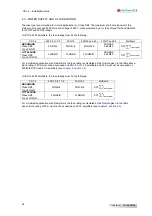
40
CD1-k- Installation Guide
Chapter 5 – Appendix
4 - ENERGY RECUPERATION VIA A BRAKING RESISTOR
All CD1 amplifiers are equipped with the power feedback system. When the motor is decelerating with high inertia
and high speed, the mechanical braking energy is reflected to the amplifier. This energy is dissipated inside a
resistor called "braking resistor".
In order to avoid heat dissipation inside the amplifier, the braking resistor is
ALWAYS
mounted outside. It
MUST
be mounted out of range of heat sensitive and inflammable elements (plastic, cable sleeves, etc.).
For an optimum power feedback by the amplifiers in a multiaxis application, the DC bus (DC+ and DC-) can be
connected in parallel (see diagram in chapter
In this case, the mains input must also be parallel wired in order to balance the current load inside the AC/DC
converters.
It is recommended to mount the braking resistor on the amplifier with highest current rating.
An electronic control of the reflected power avoids the overloading of the braking resistor. So, if the energy
reflected to the amplifiers with parallel mounted DC busses is too high, the DC bus voltage will rise up to the
triggering of the "
Overvoltage
" fault. A second resistor must then be mounted on the second axis.
5 - ORDER CODE
Single-axis version:
CD1 - k - U / I - CT
U: 230: 230 Vac voltage rating
400: 400/480 Vac voltage rating
I: 2,25 / 4,5 / 7,5 / 10,5 / 16.5 Arms
current ratings in 230 Vac
1,8 / 2,7 / 5,1 / 7,2 / 14 / 30 / 45 / 70 / 90 Arms
current ratings in 400 Vac
k: CANopen - 12 bit resolver
"Cogging torque compensation" option

































